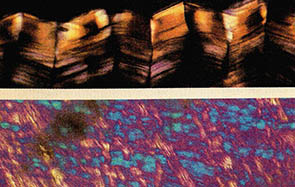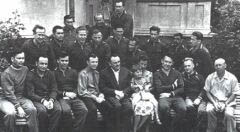이제 우리는 원자들을 이용한 게임을 즐길 수 있다. 원자들을 한번에 하나씩 꺼내 단어를 만들 수 있는 것이다. 지난 4월 IBM의 과학자인 도날드 에이글러와 어하드 슈와이쳐는 바로 그런 게임을 즐겼음을 보고했다. 그들은 원자를 이용하여 I-B-M이라는 글자를 만들어 냈다.
우리가 지금 갖고 있는 원자에 관한 지식은 아주 현대적인 것이다. 몇몇 고대 그리스의 철학자들은 모든 물질이 극히 작은 원자로 이루어져 있다고 말했지만, 그에 대한 증거는 제시하지 못했다.
1803년에 이르러서야, 영국의 화학자 존 달톤은 물질이 작은 원자로 이루어져 있다면, 원소들이 어떠한 방법으로 복합물을 형성하는지도 설명해 줄 수 있을 것이라고 지적하게 되었다. 이는 '현대원자이론'이라고 불렸는데, 19세기 내내 화학자들은 시험관에서 일어나는 모든 일들을 원자를 이용해서 설명했다.
그러나 원자는 존재하더라도 너무 작아서 눈에 보이지 않았다. 19세기의 최고의 현미경조차도, 빛의 파장이 원자를 그냥 지나칠 정도로 커서 원자의 모습을 보여줄 수 없었다.
따라서 어떤 화학자들은 '원자'라는 것이 유용한 개념이지만 그것이 반드시 존재하는 것은 아니라고 주장하기까지 했다. 사실 1달러짜리 지폐는 10센트짜리 동전 10개나 25센트짜리 4개 등으로 이해할 수 있다. 이는 잔돈 계산하는 방법을 설명해 주지만 그렇다고 1달러짜리 지폐를 찢었을 때 동전이 생기는 것은 아니다.
그러나 1905년 알버트 아인슈타인은 원자가 어떻게 분자를 작열시켜 분해하고 이동시키는지를 보여주는 방정식을 고안했다. 1913년 프랑스의 과학자 장 페린은 이 방정식을 이용해 어느 정도의 크기라야 원자의 움직임이 눈에 관측될 것인지를 계산해 냈다. 직경 2억5천만분의 1인치가 되었을 때 이러한 움직임이 보인다고 설명했다. 결국 원자들이 충돌을 일으키는 현상으로 불안정한 분자들이 움직인다는 사실은 모든 이들에게 원자의 존재를 확인시켜 주었다.
1895년엔 X선이 발견되었다. 이는 빛의 파장과 비슷한 것이었으나, 크기는 훨씬 작았다. X선은 원자를 탐지해 낼 정도로 미세했으나 그 목적에는 어울리지 않게 너무나 강력했다. X선은 빛처럼 반사되지 않고 물질을 그대로 투과했다. 또한 X선은 초점을 맞추기가 쉽지 않았다.
전자는 1896년 발견되었는데, 1923년 아더콤프톤이라는 미국의 과학자는 이 전자가 X선 크기의 파장으로 이루어져 있음을 밝혀 냈다. 그런데 전자는 초점을 맞출 수 있고, 물질로부터의 반사도 가능했다. 그 결과 평범한 빛을 이용한 현미경보다 훨씬 강력한 전자현미경이 제조될 수 있었다.
최초의 전자 현미경은 1932년 독일의 엔지니어인 어네스트 러스커에 의해 만들어졌는데 이로 인해 그는 1986년 노벨상을 수상하게 됐다.(무려 54년 후에야!)
수년에 걸쳐 전자현미경은 끊임없이 개선되어 훨씬 강력하게 되었다. 지금까지 만들어진 것 가운데에서 가장 우수한 것은 IBM의 과학자인 거드 비닝과 하인리히 로러가 1985년 발명한 '검색용 터널 현미경'이다. 그들 역시 1986년에 노벨상을 수상했다.
이 새로운 전자 현미경은 탐색면에 거의 닿을 정도의 위치로 가느다란 텅스텐 바늘을 부착한다. 작은 전류가 바늘을 거쳐 전자를 쏘면 전자는 표면을 뛰게 되고 그 결과 원자의 위치가 드러나게 된다. 이때 아주 조그맣고 특징이 없는 형태의 각각의 원자가 눈에 보일 수 있다.
몇 개의 원자들을 사이에 둔 정도만큼 떨어져 있는 표면의 원자들과 텅스텐 바늘 간에는 약간의 인력이 작용한다. 만약 바늘이 조심스럽게 조종되면 표면으로부터 하나의 원자를 끌어낼 수가 있을 것이다.
이러한 실험은 가장 큰 원자부류에 속하고 또 서로 밀착되어 있지 않은 제논원자의 경우 가장 잘 조작된다. 우선 제논원자는 니켈 표면에 뿌려진다. 보통 땐 고착성이 희박하여 붙어 있지 않지먄 니켈과 제논원자가 절대온도 영도의 상태로 냉각되면 네논원자는 힘을 모두 잃고 니켈 표면에 정지하게 된다.
그 다음 한번에 하나씩 텅스텐바늘로 원자를 잡아끌어 다른 위치에 옮기고 또다른 제논원자를 특정한 위치로 옮기는 똑같은 과정을 거듭한다. 이 모든 작업이 끝나게 되면 35개의 원자가 명확하게 IBM이라는 글자를 만들어 내는 것이다. 이는 정교한 과학기술이 만들어낸 놀랄만한 한 예로 부족함이 없다. 그러나 이것이 어떠한 소용이 있는가? 지금 당장은 별 효용성이 없다. 그러나 앞으로 원자를 조작해 일반적인 화학수단으로는 불가능한, 특수결합체(분자)의 물질을 만들어 낼 수 있을 것이다.
뿐만 아니라, 현대의 컴퓨터나 다른 전자장비를 가능케 한 마이크로칩이 언젠가 조심스럽게 위치시킨 원자들로 구성될 수도 있을 것이다. 이는 마이크로칩이 보다 마이크로화될 수 있음을 의미한다. 앞으로는 보다 짧은 시간에 훨씬 많은 일을 할 소형 컴퓨터가 탄생하게 될 것이고 인간의 뇌와 경합을 벌일 컴퓨터도 생산될 지 모를 일이다. 언젠가는 말이다!
We can now play games with single atoms, taking them one at a time and making them spell words. In April, two IBM scientists, Donald M. Eigler and Erhard K. Schweizer, reported doing so. They spelled out I-B-M using atoms to create each letter.
Our knowledge of atoms is quite modern. Some ancient Greek philosophers suggested that all matter consisted of extremely tiny atoms, but they had no evidence for it.
It wasn't until 1803, that British chemist John Dalton pointed out that if matter consisted of tiny atoms, that would explain how elements formed compounds. That was called the "modern atomic theory" and all through the 19th Century, chemists used atoms to explain everything that happened in the test tube.
However, atoms, if they existed, were so small they were invisible. Even the best 19th Century microscope couldn't show them, because light waves, small as they were, were large enough to skip over atoms and not show them.
Some chemists insisted, therefore, that although atoms were a useful concept, they did not necessarily exist. After all, it is helpful to understand that a dollar bill acts as though it is made up of 10 dimes or four quarters or other combinations of coins. It explains the system of making change, but that doesn't mean that if you tear up a dollar bill you will find coins in it.
In 1905, however, Albert Einstein worked out an equation to show how atoms(if they existed) would bombard tiny particles in solution and cause them to move randomly. In 1913, a French scientist, Jean B. Perrin, used the equation to calculate how large atoms would have to produce the motion as observed. It turned out they were about 1/250,000,000-inch across. The fact that small particles in solution do move exactly as though atoms were hitting them convinced everyone at last that atoms did exist.
In 1895, X-rays were discovered. They were like light waves but much smaller. X-rays were small enough to detect atoms, but they were too powerful for the purpose. They went right through matter instead of being reflected, as light is. Also, X-rays could not be easily focused. The electron was discovered in 1896 and in 1923, an American scientist, Arthur H. Compton, showed that it consisted of waves that were about the size of X-ray waves. Electrons, however, could be easily focused and they could be reflected from matter, too. As a result, "electron microscopes" could be built that were much more powerful than ordinary light microscopes.
The first crude electron microscope was devised in 1932 by German engineer, Ernest Ruska, and he received a Nobel Prize for that in 1986.(54 years later!)
Over the years electron microscopes were refined and made more powerful. The ultimate so far came in 1985 when two IBM scientists, Gerd Binning and Heinrich Rohrer, invented the "scanning tunneling microscope". They, too, received Nobel Prizes in 1986.
This new microscope makes use of a thin tungsten needle that is placed almost in contact with a surface being investigated. A tiny electric current shoots electrons out of the needle which bounce off the surface and show the position of the atoms that make it up. You see each atom as a tiny featureless sphere.
There is a tiny attraction between the atoms of the surface and the tungsten needle, which is only the width of a few atoms away from the surface. If the needle is carefully manipulated, it can pull a particular atom away from the surface.
This works best with atoms of xenon, which are among the largest atoms and which do not stick together very tightly. Xenon atoms are sprayed onto a nickel surface. Ordinarily, they wouldn't stay there but if the nickel surface and the xenon atoms are cooled down almost to absolute zero, the xenon atoms have so little energy that they stay put on the surface.
They are then pulled away, one at a time, by the tungsten needle, moved to a different place on the surface, and the needle is withdrawn. The xenon atom stays in the new place. Another xenon atom is brought in, and still another, each put in a particular place and, when it is done, 35 atoms clearly spell out : IBM.
It's a marvelous example of delicate scientific technique, but is it of any use? Right now, it isn't. In the future, though, it may become possible to manipulate single atoms in such a way as to form substances built up of specific combinations("molecules") of atoms, substances that cannot be formed by ordinary chemical means.
In addition, it may be that the microchips that make our modern computers and other electronic equipment possible can someday be composed of carefully placed individual atoms. This would mean that the microchips would be more "micro" than ever. We would have small computers that would do far more things in far less time, and might even be made to rival the human brain in complexity-some day!
이 기사의 내용이 궁금하신가요?
기사 전문을 보시려면500(500원)이 필요합니다.
1990년 07월 과학동아 정보
🎓️ 진로 추천
- 물리학
- 화학·화학공학
- 컴퓨터공학

















